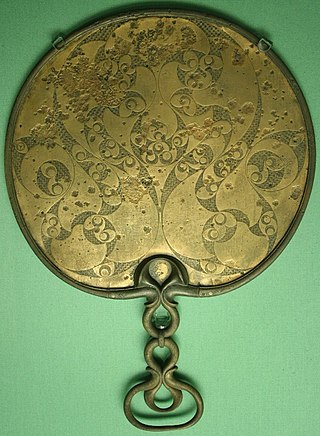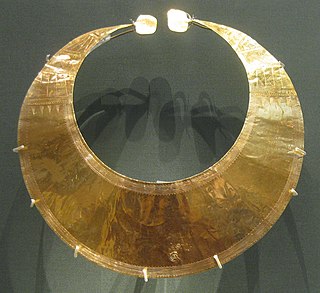
The British Museum is a public museum dedicated to human history, art and culture located in the Bloomsbury area of London. Its permanent collection of eight million works is the largest in the world. It documents the story of human culture from its beginnings to the present. Established in 1753, the British Museum was the first public national museum.

A torc, also spelled torq or torque, is a large rigid or stiff neck ring in metal, made either as a single piece or from strands twisted together. The great majority are open at the front, although some have hook and ring closures and a few have mortice and tenon locking catches to close them. Many seem designed for near-permanent wear and would have been difficult to remove.

The Bell Beaker culture, also known as the Bell Beaker complex or Bell Beaker phenomenon, is an archaeological culture named after the inverted-bell beaker drinking vessel used at the beginning of the European Bronze Age, arising from around 2800 BC.

Gobeunok or Gogok are comma-shaped or curved beads and jewels that appeared from middle age of Mumun Period through the Three Kingdoms of Korea. The Gogok is posited by researchers to have been a symbol of prestige among Mumun culture community leaders as the tombs of presumably powerful figures were oftentimes accompanied by bronze daggers, stone daggers, and comma-shaped jewels. The Gogok's role as a symbol of prestige would carry onto the Three Kingdoms Period of Korea (as Gogok would remain a salient feature of Korean royal paraphernalia. They range in size range from 1 to 10 centimetres, and are oftentimes fashioned with a hole to be attached or threaded to another object. The origin of these comma-shaped jewels are posited by some to originate from the dragon-shaped jadeite ornament of the Hongshan culture of the Liao River Basin. However, due to the spatial and temporal distance, most researchers have been skeptical of their genealogical relationship. The generally accepted interpretation in academia is that the form of the comma-shaped jewel originated from the canine teeth of predator animals such as the Magatama of Japan from the late Jōmon period or as a symbol of a half-moon sacred to moon worshippers, or as a symbol of fetus and or fertility.

A lock ring, also spelled lock-ring, is a late Bronze Age penannular hair ornament. Typically in gold, the intricate, decorative jewellery is recognized for its highly skilled workmanship. The name is derived from its suggested use as a hair fastener. Lock rings most likely originated in Ireland in the mid-eighth century B.C. They continued to be manufactured in Ireland, primarily in the River Shannon area into the seventh century B.C. Lock rings from the late Bronze Age have also been found in Great Britain and France.

Caergwrle is a village in the county of Flintshire, in north east Wales. Approximately 5–6 miles (8.0–9.7 km) from Wrexham and situated on the A541 road, it is contiguous with the villages of Abermorddu and Hope, though in parts Caergwrle and Hope are separated by a river border. The village lies on the River Alyn and sits at the base of Hope Mountain. At the 2001 Census, the population was 1,650. The population was subsequently absorbed in the community of Hope and only the electoral ward remained. The population of this ward as taken at the 2011 census was 1,619. The ward includes the area of Abermorddu. Further south is the village of Cefn-y-Bedd.

Irish art is art produced in the island of Ireland, and by artists from Ireland. The term normally includes Irish-born artists as well as expatriates settled in Ireland. Its history starts around 3200 BC with Neolithic stone carvings at the Newgrange megalithic tomb, part of the Brú na Bóinne complex which still stands today, County Meath. In early-Bronze Age Ireland there is evidence of Beaker culture and widespread metalworking. Trade-links with Britain and Northern Europe introduced La Tène culture and Celtic art to Ireland by about 300 BC, but while these styles later changed or disappeared elsewhere under Roman subjugation, Ireland was left alone to develop Celtic designs: notably Celtic crosses, spiral designs, and the intricate interlaced patterns of Celtic knotwork.

Celtic art is associated with the peoples known as Celts; those who spoke the Celtic languages in Europe from pre-history through to the modern period, as well as the art of ancient peoples whose language is uncertain, but have cultural and stylistic similarities with speakers of Celtic languages.

Prehistoric Wales in terms of human settlements covers the period from about 230,000 years ago, the date attributed to the earliest human remains found in what is now Wales, to the year AD 48 when the Roman army began a military campaign against one of the Welsh tribes. Traditionally, historians have believed that successive waves of immigrants brought different cultures into the area, largely replacing the previous inhabitants, with the last wave of immigrants being the Celts. However, studies of population genetics now suggest that this may not be true, and that immigration was on a smaller scale.

The prehistory of Ireland has been pieced together from archaeological evidence, which has grown at an increasing rate over the last decades. It begins with the first evidence of permanent human residence in Ireland around 10,500 BC and finishes with the start of the historical record around 400 AD. Both the beginning and end dates of the period are later than for much of Europe and all of the Near East. The prehistoric period covers the Palaeolithic, Mesolithic, Neolithic, Bronze Age and Iron Age societies of Ireland. For much of Europe, the historical record begins when the Romans invaded; as Ireland was not invaded by the Romans its historical record starts later, with the coming of Christianity.
The European Bronze Age is characterized by bronze artifacts and the use of bronze implements. The regional Bronze Age succeeds the Neolithic and Copper Age and is followed by the Iron Age. It starts with the Aegean Bronze Age in 3200 BC and spans the entire 2nd millennium BC, lasting until c. 800 BC in central Europe.

A gold lunula was a distinctive type of late Neolithic, Chalcolithic, and—most often—early Bronze Age necklace, collar, or pectoral shaped like a crescent moon. Most are from Prehistoric Ireland. They are normally flat and thin, with roundish spatulate terminals that are often twisted to 45 to 90 degrees from the plane of the body. Gold lunulae fall into three distinct groups, termed Classical, Unaccomplished and Provincial by archaeologists. Most have been found in Ireland, but there are moderate numbers in other parts of Europe as well, from Great Britain to areas of the continent fairly near the Atlantic coasts. Although no lunula has been directly dated, from associations with other artefacts it is thought they were being made sometime in the period between 2400 and 2000 BC; a wooden box associated with one Irish find has recently given a radiocarbon dating range of 2460–2040 BC.

Bronze Age Britain is an era of British history that spanned from c. 2500–2000 BC until c. 800 BC. Lasting for approximately 1,700 years, it was preceded by the era of Neolithic Britain and was in turn followed by the period of Iron Age Britain. Being categorised as the Bronze Age, it was marked by the use of copper and then bronze by the prehistoric Britons, who used such metals to fashion tools. Great Britain in the Bronze Age also saw the widespread adoption of agriculture.

The Banc Tynddol sun-disc is a small, decorated, gold ornament discovered near Cwmystwyth, Ceredigion, Wales. It most likely was part of a funerary garment and is dated to 2450-2150 BCE, which makes it the earliest gold artifact found in Wales. It was discovered on 16 October 2002 by a team of archaeologists who were investigating the site of Roman and medieval lead smelting hearths below the Bronze Age copper mine on Copa Hill.

The National Museum of Ireland – Archaeology is a branch of the National Museum of Ireland located on Kildare Street in Dublin, Ireland, that specialises in Irish and other antiquities dating from the Stone Age to the Late Middle Ages.

Gold working in the Bronze Age British Isles refers to the use of gold to produce ornaments and other prestige items in the British Isles during the Bronze Age, between c. 2500 and c. 800 BCE in Britain, and up to about 550 BCE in Ireland. In this period, communities in Britain and Ireland first learned how to work metal, leading to the widespread creation of not only gold but also copper and bronze items as well. Gold artefacts in particular were prestige items used to designate the high status of those individuals who wore, or were buried with them.

The Caergwrle Bowl is a unique object dating to the Middle Bronze Age, c. 1300 BC, originally manufactured from shale, tin and gold, and found in Caergwrle, Flintshire, north east Wales. It is thought to represent a boat, with its applied gold decoration signifying oars and waves, and either sun discs or circular shields. At both ends of the boat is a pair of oculi or 'eyes'.

The Coggalbeg hoard is an Early Bronze Age hoard of three pieces of Irish gold jewellery dating to 2300–2000 BC. It is now in the National Museum of Ireland – Archaeology in Dublin, where it is normally on display.

The Shropshire bulla, also known as the Shropshire sun pendant, is a Late Bronze Age gold pendant found by a metal detectorist in 2018 in Shropshire, England. Made primarily of gold, it is the eighth bulla discovered to date in Great Britain and Ireland, and only the second in Britain. The pendant, decorated with intricately carved geometric designs, is now in the British Museum in London.

The Gleninsheen gorget is a late Bronze Age collar, found in 1930 in the Gleninsheen region of the Burren, County Clare, Ireland. Given that the gorget is made from gold and weighs 276 g (8.9 ozt) it must have been intended as an ornament for a high-ranking warrior. Dated to c. 800–700 BC, it is one of the earliest examples of substantial Irish goldwork, although the gorget may represent a development of the much earlier and lighter gold lunula form. Both are mainly found in Ireland.


















